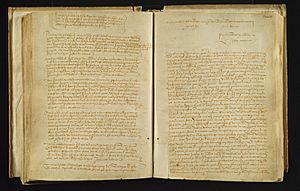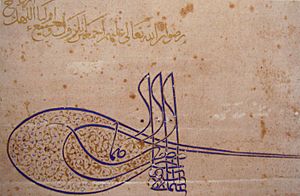Capitulation (treaty) facts for kids

A capitulation is a special kind of treaty or agreement. It's when a country allows people from another country to live within its borders but follow their own laws. This means these foreign visitors are mostly protected from the laws and courts of the country they are visiting.
The word capitulation comes from the Latin word caput, which means "head" or "chapter". This is because these agreements were often divided into different chapters.
Contents
Historical Examples of Capitulations
Capitulations have been used for a very long time in history. They helped countries deal with foreigners living in their lands.
Early Agreements in the Ottoman Empire
In the Ottoman Empire, which was a very large and powerful empire for centuries, special agreements called capitulations were made. These agreements allowed foreigners living in Ottoman lands to be judged by the laws of their home countries.
This idea wasn't new. Back in the 800s CE, the Abbasid caliph Harun al-Rashid gave special rights to Franks (people from the Frankish Empire) who visited the East. Later, independent Italian city-states like Genoa, Venice, and Pisa also got similar deals from rulers in the Middle East, including the King of Jerusalem and Saladin. Even the Byzantine Empire made these agreements with Italian cities.
Why did this happen? In those days, a country's laws usually only applied to its own citizens. Foreigners were often seen as outsiders. But as more and more foreigners, especially merchants, became wealthy and powerful in other lands, it made sense to have some rules for them. It was decided that these foreigners should follow their own laws. When the Ottoman Empire took over from the Byzantines, they continued this system. They allowed different non-Muslim groups to have their own rules for personal matters.

The first major capitulation between the Ottoman Empire and a foreign country was in 1535. It was made with the Kingdom of France. At this time, the Ottoman Empire was very strong, and the French king, Francis I, needed help. He had just lost a big battle. His only hope was the Ottoman sultan, Suleiman the Magnificent.
Francis I asked Suleiman for help because they both had a common enemy: Charles V, the powerful Holy Roman Emperor. This led to the Franco-Ottoman alliance. In 1536, the capitulations were signed. This agreement was a trade treaty. It also allowed French Christians to live in Ottoman Turkey. It said that French consuls (officials representing France) could judge civil and criminal cases involving French people in Ottoman Turkey, using French law. The consuls could even ask the sultan's officers for help to carry out their decisions.
This first capitulation became a model for others. Soon, the Ottoman Empire made similar agreements with the Republic of Venice and most other European powers, and eventually even the United States. At first, these treaties were only for the current sultan's rule. But over time, they were made to last forever.
Agreements Within Europe
Capitulations weren't just between European countries and the Ottoman Empire. Some were made between European countries themselves. For example, a treaty in 1641 between the Dutch Republic and the Kingdom of Portugal had a similar idea.
In England, capitulations started around 1569. They made sure English merchants got the same treatment as merchants from Venice, France, Poland, and the Holy Roman Empire. These agreements were updated over time. Oliver Cromwell, who ruled England for a while, also made trade treaties. His 1654 treaty with Sweden included a "most favoured nation" clause. This meant that people from either country would get the best possible privileges and freedoms in the other country, just like any other foreigner.
Swiss Capitulations for Soldiers
Between 1444 and 1792, the Kingdom of France often hired Swiss mercenaries (soldiers for hire). The agreements for these soldiers were also called "capitulations." These were contracts between the French king and different Swiss cantons (regions) or noble families.
These documents were called capitulations because they were divided into capitula (chapters). While the details varied, these agreements usually covered things like how many soldiers would be provided, how much they would be paid, and that they would be protected from French law.
See also
 In Spanish: Capitulaciones para niños
In Spanish: Capitulaciones para niños
- Ahidnâme
- Bailo of Constantinople
- Conclave capitulation
- Relazione

